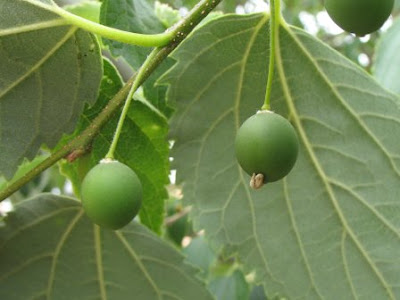 The European Hackberry (Celtis australis) is a tree species that also goes by the names European Nettle tree and Lote tree and is possibly the tree that the "Lotus-eaters" ate from as referenced by Homer.
The European Hackberry (Celtis australis) is a tree species that also goes by the names European Nettle tree and Lote tree and is possibly the tree that the "Lotus-eaters" ate from as referenced by Homer.The large specimen of the Celtis australis in the picture below is located in the "Concepción" historical botanical garden in Malaga, Spain at the beginning of the "Around the World in 80 trees" trail.
 The fruit of the European hHackberry is a small berry like "drupe" that hangs on the end of a short stem connected to the base of the leaf stem. The size of the fruit is about one half inch in diameter.
The fruit of the European hHackberry is a small berry like "drupe" that hangs on the end of a short stem connected to the base of the leaf stem. The size of the fruit is about one half inch in diameter. Below is another view of the large tree (image above) from a different angle.
Below is another view of the large tree (image above) from a different angle. The leaf of the Celtis australis is simple in shape with serrate margins and measures about 2-3 inches long. The top side is a darker green than the bottom side which is also "fuzzier" also.
The leaf of the Celtis australis is simple in shape with serrate margins and measures about 2-3 inches long. The top side is a darker green than the bottom side which is also "fuzzier" also. The bark is light gray and with age develops interesting shapes. One of the shapes in the picture below looks a bit like an eye.
The bark is light gray and with age develops interesting shapes. One of the shapes in the picture below looks a bit like an eye. I found another large example of the European Hackberry tree on the grounds of the Cathedral of Málaga. From the size of its trunk it looks like it has been growing there for a rather long time.
I found another large example of the European Hackberry tree on the grounds of the Cathedral of Málaga. From the size of its trunk it looks like it has been growing there for a rather long time.

Hi Dan,
ReplyDeleteDo you travel and take these photos? You always have such great photos of all the trees you feature on your site.
Aiyana
I have taken some of the pictures while traveling but most of them I have taken in and around the areas where I have lived. For the last four years I have been living very close to the Malaga botanical gardens where these pictures were taken.
ReplyDeletethese trees have really made the nature so beautiful..
ReplyDeleteHi Dan,
ReplyDeleteLoved to know your blogs. I am very happy with all the people that i am getting to know through the Festival os The Trees. I already placed a link to your top 12 trees post, great information!
Are you spanish, or just live in Spain? I am from São Paulo, Brazil and i am learning how to indentify trees while i write my blog... I love them!
nice to meet you
What a graceful tree. Your passion is doing wonders for my education!
ReplyDeleteDagny
www.onnotextiles.com
organic apparel
Hi,
ReplyDeleteWe want a tree that's:
(1) good for climbing;
(2) colorful in fall;
(3) able to thrive in in a city neighborhood in Nashville, TN, where it will be in partial sun; and
(4) able to survive moderate pollution, compacted soil, and occasional droughts.
Any ideas? Thank you.
Jenniesdotter
Jenniesdotter - There are most likely several species of Oak native to your area that could meet these requirements. Another good option might be a "London Plane" or an American Sycamore. I´m not sure about your area but the "Larged Leaved Lindens" might go well. They are one of my favorite climbing trees.
ReplyDeleteJenniesdotter, Where I live and have lived in Australia. we always planted a mulberry for the kids to climb. They are fast growing and have the benefit of fruit in the spring. We always classified them as "old clothes trees." Another is the deciduous cotton wood, although the sticky bud tips in spring can be a bit of a curse. Peter
ReplyDeleteyou can get them through the shade tree programs. your city might have one...
ReplyDelete